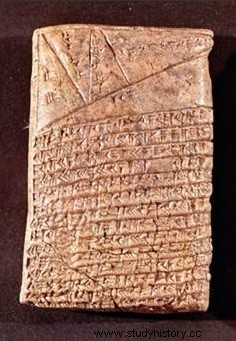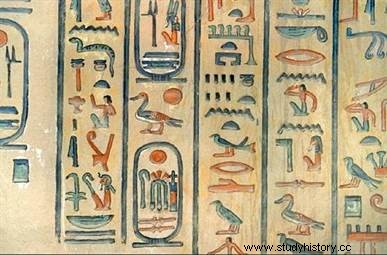 It was around 3400 BC that the Sumerians invented the first writing system called cuneiform . She waso bheld by the imprint of reeds on wet clay tablets and used to draw up inventories of goods and record commercial transactions. It took several hundred years to evolve into a more complex system and the invention of the alphabet . Its uses diversified, from the recording of legal codes and historical chronicles to the transmission of messages, including the writing of religious and literary texts. This new instrument of communication will in fact enable people to transmit their thoughts and knowledge more easily. With the invention of writing , humanity makes its entry into history.
It was around 3400 BC that the Sumerians invented the first writing system called cuneiform . She waso bheld by the imprint of reeds on wet clay tablets and used to draw up inventories of goods and record commercial transactions. It took several hundred years to evolve into a more complex system and the invention of the alphabet . Its uses diversified, from the recording of legal codes and historical chronicles to the transmission of messages, including the writing of religious and literary texts. This new instrument of communication will in fact enable people to transmit their thoughts and knowledge more easily. With the invention of writing , humanity makes its entry into history.
An invention of writing?
In order to clearly mark the difference between the signs of writing and the pictograms, we can therefore give writing in the strict sense the following definition:"system of graphic symbols allowing to record and transmit any utterance in human language”. This means that writing is linked to language by definition or, in other words, anything that can be said can be written and vice versa. As a corollary, if this is not the case, it is not writing.
 Was the writing thus defined "invented"? If so, by whom and under what circumstances? To meet possible inventors, you have to go back to the past, that is to say, in practice, turn to inscriptions whose antiquity is attested by archeology. It is then necessary to decipher these inscriptions, in other words to read them. If this is achieved, it is writing, by definition. Otherwise, the question remains open.
Was the writing thus defined "invented"? If so, by whom and under what circumstances? To meet possible inventors, you have to go back to the past, that is to say, in practice, turn to inscriptions whose antiquity is attested by archeology. It is then necessary to decipher these inscriptions, in other words to read them. If this is achieved, it is writing, by definition. Otherwise, the question remains open.
Today, four systems of ancient signs are readable:Sumerian cuneiform writing, which appeared in the land of Sumer (lower Mesopotamia) before the end of the 4th millennium BC. AD; Egyptian writing, which appeared at the same time; ancient Chinese writing, attested from the end of the 2nd millennium BC. AD; Maya writing, which appeared in the 3rd century AD. On the other hand, other systems of signs remain undeciphered, such as that of the Cretans (1800-1450 BC) or that of the Indus civilization (2500-1900 BC). .-C.).
The four systems that we know how to read have common points. Three of them were born independently in regions far apart from each other:Mesopotamia, Northern China and Mesoamerica (now Mexico and Guatemala). The same seems to be true of the Egyptian system, perhaps influenced by the Sumerian example.
From the practice of the rebus to the birth of writing
In any case, archeology shows that the use of pictograms preceded writing. In all cases also, the so-called “rebus” practice made it possible to diversify the roles of signs and opened the way to writing itself.
 The rebus is based on the distinction made between the semantic value of a sign and its phonetic value. This is how in French the juxtaposition of the drawing of a cat and the drawing of a grain can be read “chagrin”. In Sumerian, the sign (originally pictographic) corresponding to the word "plant", pronounced mu, was applied to the word "year", also pronounced mu, then to the affix mu meaning "my", then to any syllable mu.
The rebus is based on the distinction made between the semantic value of a sign and its phonetic value. This is how in French the juxtaposition of the drawing of a cat and the drawing of a grain can be read “chagrin”. In Sumerian, the sign (originally pictographic) corresponding to the word "plant", pronounced mu, was applied to the word "year", also pronounced mu, then to the affix mu meaning "my", then to any syllable mu.
This example shows how we go from the game of homonyms to a purely phonetic element:the syllable. It also shows that the practice of the rebus allows not only to write abstract words, but also and above all grammatical elements such as "my" and many others, essential for the formulation of sentences. It should be noted that in Egyptian the vowels are not taken into account in the writing; it follows that the rebus does not lead to syllables but to consonants, alone or in groups of two or three:the sign representing an owl is read "m", that representing a beetle is read "hpr", etc.
If there is any "invention" of writing, it is undoubtedly here that it is located:in the distinction between semantic value and phonetic value of symbols. But it is also possible that this distinction results from an accumulation of small empirical innovations, in other words from a progressive evolution. Be that as it may, the systems using the rebus remain very complicated, because a large number of signs continue to be used for their semantic value ("logograms") while also being used for their phonetic value ("syllabograms"). "). They are called “logo-syllabic” (or “logo-consonantal” in the Egyptian case) writings.
History of writing
As early as the first millennium BC, the great world civilizations had developed writing systems for administration, which means that one cannot truly talk about a single invention of writing. The earliest known written records are inventories of property. Discovered on clay tablets unearthed in Uruk, Mesopotamia, they date back to 3400 BC. Subsequently, some rulers recounted their exploits on stone monuments, and myths and legends relating to religious beliefs were also written down.
Early writing systems used simplified drawings (pictograms). Later they evolved into the formation of more complex phonetic signs. These two systems are still in use in different parts of the world. The Rosetta Stone, discovered at the end of the 18th century, bears witness to this cohabitation.
 Using pointed reeds, scribes in Mesopotamia traced pictographs on wet clay tablets that then dried. This form of writing is called cuneiform. The Egyptians wrote on the ancestor of paper, obtained from the papyri of the banks of the Nile. As for the Chinese, they engraved signs on animal bones. The Phoenicians bring new improvements to arrive at the first alphabet of about thirty signs, around 1200 before our era.
Using pointed reeds, scribes in Mesopotamia traced pictographs on wet clay tablets that then dried. This form of writing is called cuneiform. The Egyptians wrote on the ancestor of paper, obtained from the papyri of the banks of the Nile. As for the Chinese, they engraved signs on animal bones. The Phoenicians bring new improvements to arrive at the first alphabet of about thirty signs, around 1200 before our era.
Historians decipher many of these scriptures, but not all of them. These testimonies, if they enlighten us more than the archaeological finds, do not paint a complete picture of the first civilizations. The best known history nevertheless remains that of civilizations with a written tradition. The peoples who know the writing have indeed left many testimonies of their history that can be reported today. Thus, the conquest of Gaul by Julius Caesar (in 52 BC) is well known thanks to the memoirs written by the Roman general after his military campaigns.
Transmitting ideas and knowledge
In the centuries that followed, alphabetic writing prevailed, and the Phoenician alphabet was followed by the Greek alphabet, which itself gave birth to the alphabet. Latin. From an initial essentially mercantile and legal use, writing became a formidable tool for disseminating knowledge and literature. It will be the glory of famous authors, poets and thinkers and of antiquity, all over the world.
Over time, writing tools have changed a lot. In the Middle Ages, the reed tip of the Sumerians and Egyptians gave way to the bird feather. Clay plates and papyrus are replaced by paper, which the Chinese make with tree bark at the beginning of our era, or which the Europeans produce, from the Renaissance, with rags. The improvements in the various writing media, such as the invention of the printing press in the 15th century, will contribute to its durability and its evolution over time. Cursive writing, which aims to simplify the lines, will ensure its accessibility to as many people as possible.
To go further
- The History of Writing, by Louis-Jean Calvet. Plural, 2011.
- The Fabulous Story of the Invention of Writing, by Silvia Ferrara. Threshold, 2021.
- Birth of writing, by Michel Renouard. West-France, 2015.
